Clade †Hallucishaniids Scientific name Hallucigenia Rank Genus | Stem group Onychophora Family †Hallucigeniidae Higher classification Hallucigeniidae | |
 | ||
Similar Opabinia, Anomalocaris, Pikaia, Wiwaxia, Onychophora | ||
Hallucigenia the worm with the missing head
Hallucigenia is a genus of Cambrian xenusiids known from articulated fossils in Burgess Shale-type deposits in Canada and China, and from isolated spines around the world. Its quirky name reflects its unusual appearance and eccentric history of study; when it was erected as a genus, the animal was reconstructed upside down and back to front. Hallucigenia is now recognized as a "lobopodian worm". It is considered by some to represent an early ancestor of the living velvet worms, although other researchers favour a relationship closer to arthropods.
Contents
- Hallucigenia the worm with the missing head
- Hallucigenia at the chicago field museum
- Description
- History of study
- Affinity
- Diversity
- Distribution
- References

Hallucigenia at the chicago field museum
Description
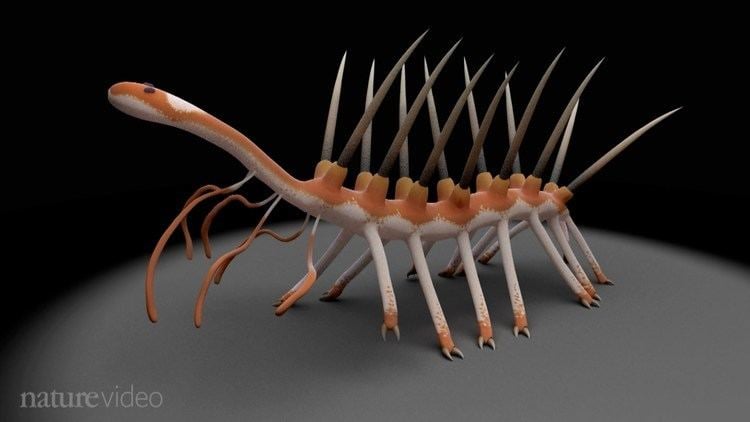
Hallucigenia is a 0.5—3.5 cm long tubular organism with seven or eight pairs of slender legs, each terminating with a pair of claws. Above each leg is a rigid conical spine. The 'head' and 'tail' end of the organism are difficult to identify; one end extends some distance beyond the legs and often droops down as if to reach the substrate. Although some specimens display traces of a gut, the internal anatomy has not been formally described. Recent research suggests that the extended element is an elongated head with two simple eyes, a mouth with radial teeth, and pharyngeal teeth within the front of the gut.
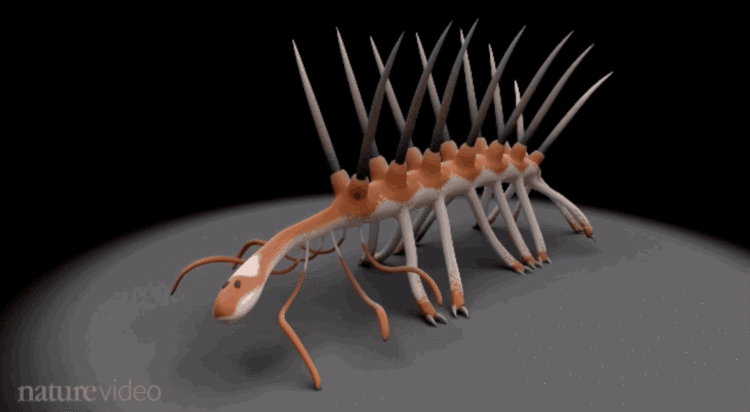
Hallucigenia's spines are made up of one to four nested elements. Their surface is covered in an ornament of minute triangular 'scales'.
History of study
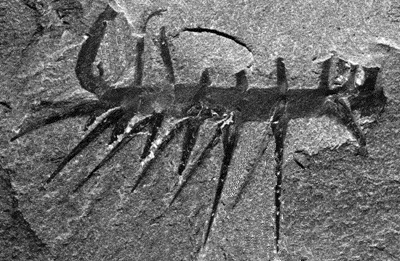
Hallucigenia was originally described by Walcott as a species of the polychaete worm Canadia. In his 1977 redescription of the organism, Simon Conway Morris recognized the animal as something quite distinct, establishing the new genus. No specimen was available that showed both rows of legs, and as such Conway Morris reconstructed the animal walking on its spines, with its single row of legs interpreted as tentacles on the animal's back. A dark stain at one end of the animal was interpreted as a featureless head. Only the forward tentacles could easily reach to the 'head', meaning that a mouth on the head would have to be fed by passing food along the line of tentacles. Conway Morris suggested that a hollow tube within each of the tentacles might be a mouth. This raised questions, such as how it would walk on the stiff legs, but it was accepted as the best available interpretation.
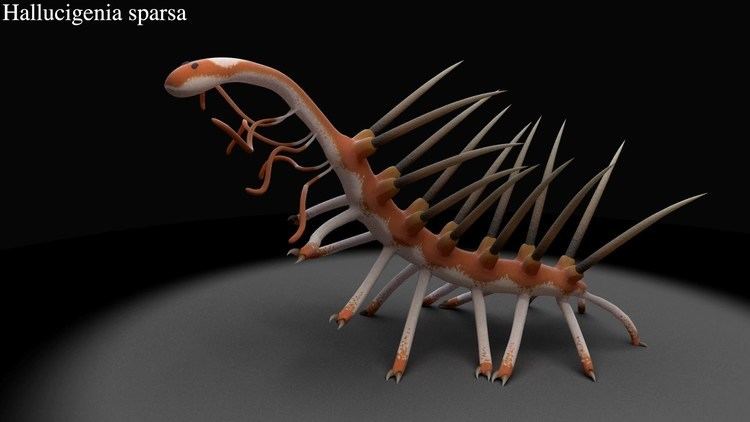
An alternative interpretation considered Hallucigenia to be an appendage of a larger, unknown animal. There had been precedent for this, as Anomalocaris had been originally identified as three separate creatures before being identified as a single huge (for its time) 3-foot-long (0.91 m) creature. Given the uncertainty of its taxonomy, Hallucigenia was tentatively placed within the phylum Lobopodia, a catch-all taxon containing numerous odd "worms with legs".
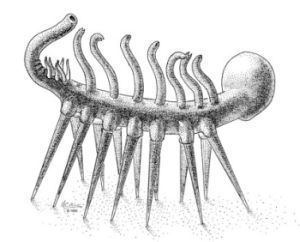
In 1991, Lars Ramskold and Hou Xianguang, working with additional specimens of a "hallucigenid", Microdictyon, from the lower Cambrian Maotianshan shales of China, reinterpreted Hallucigenia as an Onychophoran (velvet worm). They inverted it, interpreting the tentacles, which they believe to be paired, as walking structures and the spines as protective. Further preparation of fossil specimens showed that the 'second legs' were buried at an angle to the plane along which the rock had split, and could be revealed by removing the overlying sediment. Ramskold and Hou also believe that the blob-like 'head' is actually a stain that appears in many specimens, not a preserved portion of the anatomy. This stain may be an artefact of decomposition.
Affinity
Hallucigenia is unquestionably a panarthropod, and has long been interpreted as a stem-group onychophoran – a position that has now found support from phylogenetic analysis. A key character demonstrating this affinity is the cone-in-cone construction of Hallucigenia claws, a feature shared only with modern onychophorans. Hallucigenia also exhibits certain characters inherited from the ancestral ecdysozoan, but lost in the modern onychophorans – in particular its distinctive foregut armature.
Diversity
In 2002, Desmond Collins informally suggested that new Hallucigenia fossils from the Burgess Shale showed male and female forms, one with "a rigid trunk, robust neck and a globular head" and the other thinner, and with a small head.
Further species are represented from the Chengjiang.
Distribution
Hallucigenia was first described from the Burgess Shale in southwestern British Columbia, Canada. 109 specimens of Hallucigenia are known from the Greater Phyllopod bed, where they comprise 0.3% of the community. Hallucigenia also forms a minor component of Chinese lagerstätten. Isolated hallucigeniid spines, however, are widely distributed in a range of Cambrian deposits, preserved both as carbonaceous and mineralized fossils.
